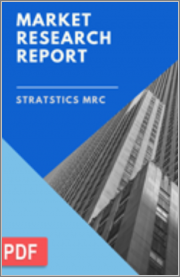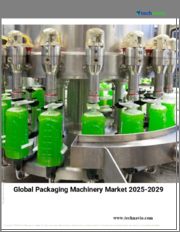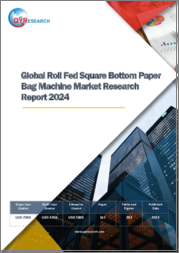
|
시장보고서
상품코드
1383369
무균 포장기 시장 예측(-2030년) : 유형, 재료, 용도, 지역별 세계 분석Aseptic Packaging Machinery Treatment Market Forecasts to 2030 - Global Analysis By Type, Material, Application and By Geography |
||||||
Stratistics MRC에 따르면 세계 무균 포장기 시장은 2023년 98억 2,000만 달러로 예측 기간 동안 CAGR 9.9%로 성장하여 2030년 190억 1,000만 달러에 달할 것으로 예상됩니다.
무균 처리된 제품을 생산하고 포장하는 데 사용되는 기계를 무균 포장기라고 합니다. 제품의 무결성과 유통기한을 유지하기 위해 무균 처리에서는 제품과 포장재를 별도로 멸균한 후 무균 상태에서 합체해야 합니다. 이는 무균 환경에서 충전 및 밀봉하는 동안 제품이 깨끗하게 유지되도록 보장하기 때문에 이 절차에 필수적입니다.
제품의 품질 유지
무균 처리 및 포장은 제품이 고열 및 장시간 조리되는 것을 최소화하여 내용물의 색상, 풍미 및 영양가를 유지합니다. 이는 특히 열에 민감한 제품에 중요합니다. 이 기계는 병, 상자, 파우치, 바이알 등 다양한 포장 형태에 대응할 수 있으며, 소비자의 취향에 맞는 포장 디자인과 크기의 유연성을 제공합니다. 이러한 것들이 시장 성장에 영향을 미치는 요인입니다.
복잡한 생산 공정
무균 식품 포장의 제조는 복잡하며, 품질을 유지하면서 생산성을 향상시키기 위해서는 고도의 장비가 필요합니다. 무균 포장을 위한 슬리팅 및 와인딩 솔루션은 까다롭고 최첨단 기술이 필요합니다. 또한, 제조 공정에서 무균 시장 포장은 슬리팅 및 와인딩 기계와 식품용 부품이 장착된 오일 프리 전기 기계와 관련된 높은 생산 및 유지보수 비용으로 인해 제약이 있습니다. 대체 포장 옵션의 가용성과 엄격한 플라스틱 사용 규제는 시장 성장을 억제할 것으로 예상되는 두 가지 요인입니다.
친환경 포장에 대한 수요 증가
친환경 포장의 가치에 대한 일반 소비자의 인식이 높아지고, 정부의 열등한 플라스틱 사용을 금지하는 엄격한 규제와 콜드체인 물류 비용의 감소로 인해 무균 포장에 대한 소비자의 관심이 높아질 것으로 예상됩니다. 도시화가 진행됨에 따라 유제품, 식음료 및 오래 지속되는 상품에 대한 수요가 증가하고 있습니다. 무균 포장 솔루션에 대한 소비자 수요는 무방부제 식품과 생식용 식품이 주도할 것으로 예상됩니다.
높은 초기 투자비용
무균 충전기는 고가의 정교한 장비로 설치 및 설정에 많은 초기 비용이 소요됩니다. 설치 및 도입에 시간이 걸리기 때문에 초기 투자 비용이 높습니다. 또한 장비의 유지 관리에도 많은 비용과 시간이 필요합니다. 따라서 포장 장비 설치에 소요되는 시간이 길어짐에 따라 예상 기간 동안 시장 확대를 저해하는 요인이 됩니다.
COVID-19의 영향:
COVID-19의 영향으로 시장 확대가 둔화됐습니다. 전 세계 운송 및 물류 중단, 식품 및 음료와 같은 최종사용자의 수요 감소로 인해 발생했습니다. 그러나 광범위한 예방접종 캠페인의 시작은 온라인 구매의 증가로 이어져 예측 기간 동안 시장 확대를 촉진할 것으로 예상됩니다.
예측 기간 동안 플라스틱 부문이 가장 큰 비중을 차지할 것으로 예상
예측 기간 동안 플라스틱 부문이 가장 큰 비중을 차지할 것으로 예상됩니다. 기존의 무균 포장은 유효성, 가공성 및 비용 효율성을 향상시키기 위해 플라스틱을 많이 사용합니다. 포장의 효과와 효율성을 향상시키기 위해 화학제품, 열, 방사선 조사를 사용하여 재료를 멸균, 성형, 포장 및 밀봉합니다. 플라스틱은 그릇, 쟁반, 가방, 호일, 병, 냄비, 컵, 파우치 등의 생산으로 인해 높은 수요가 예상됩니다.
예측 기간 동안 제약 분야가 가장 높은 CAGR을 기록할 것으로 예상
제약 분야는 예측 기간 동안 가장 높은 CAGR을 기록할 것으로 예상됩니다. 주사제, 백신 및 기타 무균 의약품과 같은 품목에는 무균 포장이 필수적입니다. 제약 산업은 무균과 제품 안전성을 중요시하기 때문에 무균 포장기는 의약품의 무결성을 유지하기 위해 필요합니다. 무균 포장에 대한 요구가 증가하는 것은 의약품의 청결을 보호해야 할 필요성에 의해 발생합니다.
가장 큰 점유율을 차지하는 지역
예측 기간 동안 북미 지역이 가장 큰 시장 점유율을 차지할 것으로 예상됩니다. 환경 문제에 대한 관심, 유통기한이 연장된 제품에 대한 고객 수요, 무균 포장에 대한 요구가 모두 증가할 것으로 예상됩니다. 가공되지 않은 화학제품이 없는 식품을 먹고자 하는 소비자의 욕구와 식품 방부제 사용의 위험성에 대한 일반 대중의 인식이 높아지는 것이 시장 수익 성장을 촉진하는 주요 요인입니다.
CAGR이 가장 높은 지역:
아시아태평양은 예측 기간 동안 가장 높은 CAGR을 유지할 것으로 예상됩니다. 소비자의 라이프스타일 변화와 아시아 소비자의 소비력 증가로 인해 포장 식품 및 음료에 대한 수요 증가는 무균 포장 장비 시장에 도움이 될 가능성이 높습니다. 최종사용자의 수요 증가에 대응하기 위해 신흥 경제 국가의 제조업체들이 이 지역으로 제조 시설을 이전할 것으로 예상되며, 이는 시장 확대에 도움이 될 것으로 보입니다.
무료 커스터마이징 제공:
이 보고서를 구독하는 고객은 다음과 같은 무료 맞춤형 옵션 중 하나를 사용할 수 있습니다:
- 회사 프로필
- 추가 시장 기업의 종합적인 프로파일링(최대 3개사까지)
- 주요 기업 SWOT 분석(3개사까지)
- 지역 세분화
- 고객의 관심에 따른 주요 국가별 시장 추정 및 예측, CAGR(참고: 타당성 검토에 따른)
- 경쟁사 벤치마킹
- 제품 포트폴리오, 지리적 입지, 전략적 제휴를 기반으로 한 주요 기업 벤치마킹
목차
제1장 주요 요약
제2장 서문
- 개요
- 이해관계자
- 조사 범위
- 조사 방법
- 데이터 마이닝
- 데이터 분석
- 데이터 검증
- 조사 접근법
- 조사 소스
- 1차 조사 소스
- 2차 조사 소스
- 가정
제3장 시장 동향 분석
- 성장 촉진요인
- 성장 억제요인
- 기회
- 위협
- 용도 분석
- 신흥 시장
- 신종 코로나바이러스 감염증(COVID-19)의 영향
제4장 Porter's Five Forces 분석
- 공급 기업의 교섭력
- 구매자의 교섭력
- 대체품의 위협
- 신규 참여업체의 위협
- 경쟁 기업 간의 경쟁 관계
제5장 세계의 무균 포장기 시장 : 유형별
- 충전기
- 실링기
- FFS(Form-Fill-Seal) 포장기
- 캡핑 머신
- 카톤 충전기
- 봉투 충전기
- 블로우 성형기
- 파우치 충전기
- 기타 유형
제6장 세계의 무균 포장기 시장 : 재료별
- 종이·판지
- 금속
- 유리
- 목재
- 플라스틱
- 강철
- 알루미늄
- 구리
- 고무
- 기타 재료
제7장 세계의 무균 포장기 시장 : 용도별
- 식품·음료
- 의약품
- 퍼스널케어
- 화학제품
- 바이오테크놀러지
- 바이오의약품
- 반려동물 사료
- 테트라팩 카톤
- 기타 용도
제8장 세계의 무균 포장기 시장 : 지역별
- 북미
- 미국
- 캐나다
- 멕시코
- 유럽
- 독일
- 영국
- 이탈리아
- 프랑스
- 스페인
- 기타 유럽
- 아시아태평양
- 일본
- 중국
- 인도
- 호주
- 뉴질랜드
- 한국
- 기타 아시아태평양
- 남미
- 아르헨티나
- 브라질
- 칠레
- 기타 남미
- 중동 및 아프리카
- 사우디아라비아
- 아랍에미리트
- 카타르
- 남아프리카공화국
- 기타 중동 및 아프리카
제9장 주요 발전
- 계약, 파트너십, 협업, 합작투자
- 인수와 합병
- 신제품 발매
- 사업 확대
- 기타 주요 전략
제10장 기업 개요
- Roquette
- Cargill Inc.
- Tetra Pak
- Dr. Oetker
- Tate and Lyle plc
- Grain Processing Corporation
- SIG Combibloc Inc.
- Queen Fine Foods
- Ingredion Incorporated
- Uflex
- Krones AG
- Bosch Packaging Technology, Inc
- DS Smith PLC
- Coveris Holdings SA
- IC Filling Systems
According to Stratistics MRC, the Global Aseptic Packaging Machinery Market is accounted for $9.82 billion in 2023 and is expected to reach $19.01 billion by 2030 growing at a CAGR of 9.9% during the forecast period. Machinery used in the production and packing of aseptically treated goods is referred to as aseptic packaging machinery. To preserve the product's integrity and shelf life, aseptic processing requires sterilizing the product and the packaging material separately before merging them under sterile circumstances. This is essential to the procedure because it guarantees that the product is kept clean while being filled and sealed in a sterile environment.
Market Dynamics:
Driver:
Preservation of product quality
Aseptic processing and packaging minimize the exposure of the product to high heat and long cooking times, preserving the color, flavor, and nutritional value of the contents. This is particularly important for heat-sensitive products. This machinery can handle a variety of packaging formats, including bottles, cartons, pouches, and a vial, offering flexibility in packaging design and sizes to meet consumer preferences. These are the factors influencing the growth of the market.
Restraint:
Complex manufacturing processes
Production of aseptic food packaging is intricate and requires sophisticated equipment to increase productivity while preserving quality. Slitting and winding solutions for aseptic packaging are difficult and need cutting-edge technology. Additionally, aseptic market packaging in the manufacturing process is constrained by the higher production and maintenance costs associated with oil-free electric machinery equipped with slitter rewinders and food-grade components. The availability of alternative packaging options and strict plastic usage regulations are the two factors that are expected to restrain market growth.
Opportunity:
Growing demand for environmentally friendly packaging
Consumer interest in aseptic packaging is projected to rise as a result of growing public awareness of the value of ecologically friendly packaging, stringent governmental regulations banning the use of subpar plastics, and decreasing logistical costs in the cold chain. The demand for dairy products, packaged beverages and foods, and long-lasting goods has increased as urbanization increases. Consumer demand for aseptic packaging solutions is projected to be driven by food without preservatives and raw foods.
Threat:
High Initial Investment
Aseptic filling machines are expensive and sophisticated pieces of equipment with significant initial expenditures for installation and setup. The time needed for installation and implementation results in higher initial investment expenses. Additionally, more money and time are needed for the installation's equipment upkeep. Therefore, the prolonged time needed for the installation of packing equipment prevents the market from expanding during the anticipated term.
COVID-19 Impact:
The market expansion was slowed down as a result of COVID-19. It occurs as a result of the global suspension of transportation and logistics as well as decreased demand from end-user businesses like the food and beverage sectors. However, the start of widespread immunization campaigns led to an increase in online buying, which is anticipated to fuel market expansion over the course of the projection period.
The plastic segment is expected to be the largest during the forecast period
The plastic segment is expected to be the largest during the forecast period. Traditional aseptic packaging makes extensive use of plastic to improve efficacy, processability, and cost-efficiency. To improve the efficacy and efficiency of the packaging, materials are sterilized, molded, packed, and sealed utilizing chemicals, heat, and irradiation. Plastic should be in high demand due to the production of bowls, trays, bags, foils, bottles, pots, cups, and pouches.
The pharmaceutical segment is expected to have the highest CAGR during the forecast period
The pharmaceutical segment is expected to have the highest CAGR during the forecast period. For items like injectable drugs, vaccines, and other sterile pharmaceutical supplies, aseptic packaging is essential. Aseptic machines are necessary to maintain the integrity of pharmaceutical goods since the industry places a high priority on sterility and product safety. The growing need for aseptic packaging is being driven by the need to protect pharmaceutical items' cleanliness.
Region with largest share:
North America is projected to hold the largest market share during the forecast period. Environmental concerns, customer demand for products with extended shelf life, and the need for aseptic packaging are all predicted to rise. Consumer desire for eating unprocessed, chemical-free foods and growing public knowledge about the dangers of using food preservatives are the main factors driving market revenue growth.
Region with highest CAGR:
Asia Pacific is projected to hold the highest CAGR over the forecast period. Rising demand for packaged food and beverage goods is likely to benefit the aseptic packaging equipment market due to changing consumer lifestyles and increased spending power among Asian consumers. To meet the expanding demand from end users, manufacturers from developed economies are anticipated to relocate their manufacturing facilities in the area, which would boost market expansion.
Key players in the market
Some of the key players in Aseptic Packaging Machinery market include: Roquette, Cargill Inc., Tetra Pak, Dr. Oetker, Tate and Lyle plc, Grain Processing Corporation, SIG Combibloc Inc., Queen Fine Foods. Ingredion Incorporated, Uflex, Krones AG, Bosch Packaging Technology, Inc, DS Smith PLC, Coveris Holdings SA and IC Filling Systems.
Key Developments:
In March 2023, Qatar-based leading producer of dairy-based beverages, Balanda, announced a strategic partnership with SIG, a packaging solution provider, in order to bring a new aseptic packaging solution. Under the agreement, companies will be producing aseptic packaging in the form of cartons, especially for white cheese.
In March 2022: 'SIG Combibloc Inc.' showcased an innovative full-barrier, aluminum-free, aseptic carton pack solution called "SIGNATURE EVO." It is already available for plain white dairy milk. SIGNATURE EVO's usage extends to a broader portfolio of oxygen-sensitive products like fruit juices, nectars, flavored milk, and plant-based beverages.
In January 2022: Asepto from UFlex has been chosen as the packaging partner for the FDC brand "Electral Z+ (ORS+Zinc Solution)," an OTC ready-to-drink product. The product features a formulation manufactured by 'Halewood Laboratories Private Ltd'.
Types Covered:
- Filling Machines
- Sealing Machines
- Form-Fill-Seal Machines
- Capping Machines
- Carton Filling Machines
- Bag Filling Machines
- Blow Molding Machines
- Pouch Filling Machines
- Other Types
Materials Covered:
- Paper & paperboard
- Metal
- Glass
- Wood
- Plastic
- Steel
- Aluminum
- Copper
- Rubber
- Other Materials
Applications Covered:
- Food & Beverage
- Pharmaceutical
- Personal Care
- Chemical
- Biotechnology
- Biopharmaceuticals
- Pet Food
- Tetra Pak Cartons
- Other Applications
Regions Covered:
- North America
- US
- Canada
- Mexico
- Europe
- Germany
- UK
- Italy
- France
- Spain
- Rest of Europe
- Asia Pacific
- Japan
- China
- India
- Australia
- New Zealand
- South Korea
- Rest of Asia Pacific
- South America
- Argentina
- Brazil
- Chile
- Rest of South America
- Middle East & Africa
- Saudi Arabia
- UAE
- Qatar
- South Africa
- Rest of Middle East & Africa
What our report offers:
- Market share assessments for the regional and country-level segments
- Strategic recommendations for the new entrants
- Covers Market data for the years 2021, 2022, 2023, 2026, and 2030
- Market Trends (Drivers, Constraints, Opportunities, Threats, Challenges, Investment Opportunities, and recommendations)
- Strategic recommendations in key business segments based on the market estimations
- Competitive landscaping mapping the key common trends
- Company profiling with detailed strategies, financials, and recent developments
- Supply chain trends mapping the latest technological advancements
Free Customization Offerings:
All the customers of this report will be entitled to receive one of the following free customization options:
- Company Profiling
- Comprehensive profiling of additional market players (up to 3)
- SWOT Analysis of key players (up to 3)
- Regional Segmentation
- Market estimations, Forecasts and CAGR of any prominent country as per the client's interest (Note: Depends on feasibility check)
- Competitive Benchmarking
- Benchmarking of key players based on product portfolio, geographical presence, and strategic alliances
Table of Contents
1 Executive Summary
2 Preface
- 2.1 Abstract
- 2.2 Stake Holders
- 2.3 Research Scope
- 2.4 Research Methodology
- 2.4.1 Data Mining
- 2.4.2 Data Analysis
- 2.4.3 Data Validation
- 2.4.4 Research Approach
- 2.5 Research Sources
- 2.5.1 Primary Research Sources
- 2.5.2 Secondary Research Sources
- 2.5.3 Assumptions
3 Market Trend Analysis
- 3.1 Introduction
- 3.2 Drivers
- 3.3 Restraints
- 3.4 Opportunities
- 3.5 Threats
- 3.6 Application Analysis
- 3.7 Emerging Markets
- 3.8 Impact of Covid-19
4 Porters Five Force Analysis
- 4.1 Bargaining power of suppliers
- 4.2 Bargaining power of buyers
- 4.3 Threat of substitutes
- 4.4 Threat of new entrants
- 4.5 Competitive rivalry
5 Global Aseptic Packaging Machinery Market, By Type
- 5.1 Introduction
- 5.2 Filling Machines
- 5.3 Sealing Machines
- 5.4 Form-Fill-Seal Machines
- 5.5 Capping Machines
- 5.6 Carton Filling Machines
- 5.7 Bag Filling Machines
- 5.8 Blow Molding Machines
- 5.9 Pouch Filling Machines
- 5.10 Other Types
6 Global Aseptic Packaging Machinery Market, By Material
- 6.1 Introduction
- 6.2 Paper & paperboard
- 6.3 Metal
- 6.4 Glass
- 6.5 Wood
- 6.6 Plastic
- 6.7 Steel
- 6.8 Aluminum
- 6.9 Copper
- 6.10 Rubber
- 6.11 Other Materials
7 Global Aseptic Packaging Machinery Market, By Application
- 7.1 Introduction
- 7.2 Food & Beverage
- 7.3 Pharmaceutical
- 7.4 Personal Care
- 7.5 Chemical
- 7.6 Biotechnology
- 7.7 Biopharmaceuticals
- 7.8 Pet Food
- 7.9 Tetra Pak Cartons
- 7.10 Other Applications
8 Global Aseptic Packaging Machinery Market, By Geography
- 8.1 Introduction
- 8.2 North America
- 8.2.1 US
- 8.2.2 Canada
- 8.2.3 Mexico
- 8.3 Europe
- 8.3.1 Germany
- 8.3.2 UK
- 8.3.3 Italy
- 8.3.4 France
- 8.3.5 Spain
- 8.3.6 Rest of Europe
- 8.4 Asia Pacific
- 8.4.1 Japan
- 8.4.2 China
- 8.4.3 India
- 8.4.4 Australia
- 8.4.5 New Zealand
- 8.4.6 South Korea
- 8.4.7 Rest of Asia Pacific
- 8.5 South America
- 8.5.1 Argentina
- 8.5.2 Brazil
- 8.5.3 Chile
- 8.5.4 Rest of South America
- 8.6 Middle East & Africa
- 8.6.1 Saudi Arabia
- 8.6.2 UAE
- 8.6.3 Qatar
- 8.6.4 South Africa
- 8.6.5 Rest of Middle East & Africa
9 Key Developments
- 9.1 Agreements, Partnerships, Collaborations and Joint Ventures
- 9.2 Acquisitions & Mergers
- 9.3 New Product Launch
- 9.4 Expansions
- 9.5 Other Key Strategies
10 Company Profiling
- 10.1 Roquette
- 10.2 Cargill Inc.
- 10.3 Tetra Pak
- 10.4 Dr. Oetker
- 10.5 Tate and Lyle plc
- 10.6 Grain Processing Corporation
- 10.7 SIG Combibloc Inc.
- 10.8 Queen Fine Foods
- 10.9 Ingredion Incorporated
- 10.10 Uflex
- 10.11 Krones AG
- 10.12 Bosch Packaging Technology, Inc
- 10.13 DS Smith PLC
- 10.14 Coveris Holdings SA
- 10.15 IC Filling Systems



















